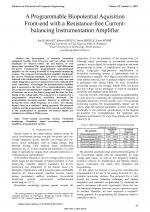| 2/2018 - 11 |
A Programmable Biopotential Aquisition Front-end with a Resistance-free Current-balancing Instrumentation AmplifierFARAGO, P. |
| Extra paper information in |
| Click to see author's profile in |
| Download PDF |
Author keywords
analog processing circuits, biomedical monitoring, biomedical signal processing, operational amplifiers, programmable circuits
References keywords
amplifier(18), circuits(15), instrumentation(13), systems(11), noise(8), design(8), current(8), cmos(8), state(6), solid(6)
Blue keywords are present in both the references section and the paper title.
About this article
Date of Publication: 2018-05-31
Volume 18, Issue 2, Year 2018, On page(s): 85 - 92
ISSN: 1582-7445, e-ISSN: 1844-7600
Digital Object Identifier: 10.4316/AECE.2018.02011
Web of Science Accession Number: 000434245000011
SCOPUS ID: 85047865716
Abstract
The development of wearable biomedical equipment benefits from low-power and low-voltage circuit techniques for reduced battery size and battery, or even battery-less, operation. This paper proposes a fully-differential low-power resistance-free programmable instrumentation amplifier for the analog front-end of biopotential monitoring systems. The proposed instrumentation amplifier implements the current balancing technique. Low power consumption is achieved with subthreshold biasing. To reduce chip area and enable integration, passive resistances have been replaced with active equivalents. Accordingly, the instrumentation amplifier gain is expressed as the ratio of two transconductance values. The proposed instrumentation amplifier exhibits two degrees of freedom: one to set the desired range and the other for fine-tuning of the voltage gain. The proposed IA is employed in a programmable biopotential acquisition front-end. The programmable frequency-selective behavior is achieved by having the lower cutoff frequency of a Gm-C Tow-Thomas biquad varied in a constant-C tuning approach. The proposed solutions and the programmability of the operation parameters to the specifications of particular bio-medical signals are validated on a 350nm CMOS process. |
| References | | | Cited By |
Web of Science® Times Cited: 2 [View]
View record in Web of Science® [View]
View Related Records® [View]
Updated today
SCOPUS® Times Cited: 4
View record in SCOPUS® [Free preview]
View citations in SCOPUS® [Free preview]
[1] Ultra-wideband Low-Noise Amplifier with Tunable Bandwidth, Yousefi, Mousa, Seyyed Najjar Hoseini, Seyyed Mojtaba, Monfaredi, Khalil, Circuits, Systems, and Signal Processing, ISSN 0278-081X, Issue 5, Volume 42, 2023.
Digital Object Identifier: 10.1007/s00034-022-02249-3 [CrossRef]
[2] A Novel Wearable Foot and Ankle Monitoring System for the Assessment of Gait Biomechanics, Faragó, Paul, Grama, Lăcrimioara, Farago, Monica-Adriana, Hintea, Sorin, Applied Sciences, ISSN 2076-3417, Issue 1, Volume 11, 2020.
Digital Object Identifier: 10.3390/app11010268 [CrossRef]
Disclaimer: All information displayed above was retrieved by using remote connections to respective databases. For the best user experience, we update all data by using background processes, and use caches in order to reduce the load on the servers we retrieve the information from. As we have no control on the availability of the database servers and sometimes the Internet connectivity may be affected, we do not guarantee the information is correct or complete. For the most accurate data, please always consult the database sites directly. Some external links require authentication or an institutional subscription.
Web of Science® is a registered trademark of Clarivate Analytics, Scopus® is a registered trademark of Elsevier B.V., other product names, company names, brand names, trademarks and logos are the property of their respective owners.
Faculty of Electrical Engineering and Computer Science
Stefan cel Mare University of Suceava, Romania
All rights reserved: Advances in Electrical and Computer Engineering is a registered trademark of the Stefan cel Mare University of Suceava. No part of this publication may be reproduced, stored in a retrieval system, photocopied, recorded or archived, without the written permission from the Editor. When authors submit their papers for publication, they agree that the copyright for their article be transferred to the Faculty of Electrical Engineering and Computer Science, Stefan cel Mare University of Suceava, Romania, if and only if the articles are accepted for publication. The copyright covers the exclusive rights to reproduce and distribute the article, including reprints and translations.
Permission for other use: The copyright owner's consent does not extend to copying for general distribution, for promotion, for creating new works, or for resale. Specific written permission must be obtained from the Editor for such copying. Direct linking to files hosted on this website is strictly prohibited.
Disclaimer: Whilst every effort is made by the publishers and editorial board to see that no inaccurate or misleading data, opinions or statements appear in this journal, they wish to make it clear that all information and opinions formulated in the articles, as well as linguistic accuracy, are the sole responsibility of the author.



